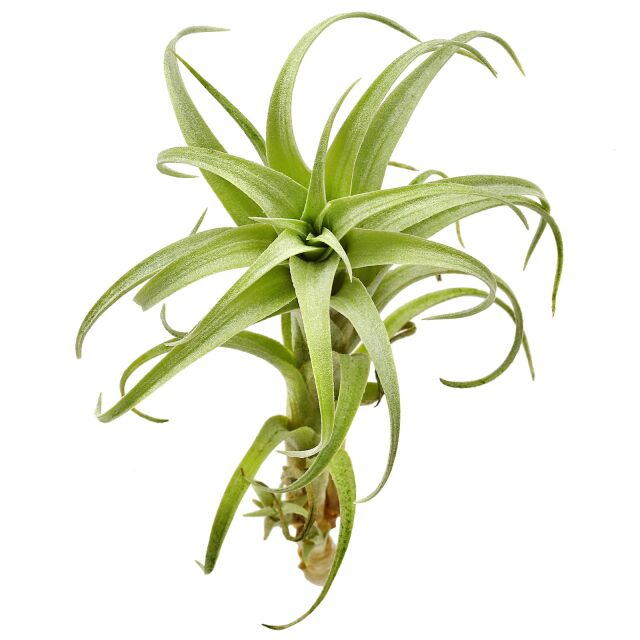Dwarf air plant



Tillandsia nana
Dwarf air plant
- Rock-dwelling plant from the Andes
- Quite broad, curved leaves on stems
- Pink flowers
Item question
We’re here for you!
Please enter your question and e-mail and we’ll contact you as soon as possible. It usually takes us up to 24 hours during business days to respond.
Thank you for your question!
Thank you, we’ll get in touch!
Close window
You already sent us a question.
Please wait a few minutes
Description
Tillandsia nana is native to the Andes of Peru and Bolivia in altitudes of 2900 - 3500 m. It occurs on cliffs (lithophyte, saxicolous plant) in contrast to many other Tillandsias that mostly occur as epiphytes on trees. This species is also known under the synonym Tillandsia calocephala. The silvery grey-green, 6 - 10 cm long, curved leaves are arranged along a stem and are triangular in shape. Older shoots grow more or less pendulous with the shoot tips pointing upwards. When the plant comes into flower, a small, compact inflorescence with some tubular purple flowers appears at the shoot tip. With time, the plant forms a tuft with its side shoots.
T. nana belongs to the type of "grey tillandsias". These plants usually come from drier, more exposed places than the so-called green tillandsias. They often grow higher up in the treetops, in dry forests or even in deserts with a lot of fog. These atmospheric plants absorb water and nutrients from rain, mist and dust completely via the many absorbent scales on the leaves. The roots, if still present, serve as an adhesive organ. In culture, such tillandsias are tied or glued to hard materials such as wood or stones. The species prefers a very light, airy place. Spray the plants with soft water about two to three times a week. Dipping is also possible. After watering, the plant should be allowed to dry. Ideally, an orchid and tillandsia fertiliser should be added every second watering during spring and summer.
Like almost all tillandsias, T. nana also forms several pups at its base after blooming. These can be carefully separated when they reach a size of about one third of the mother plant. If they are not separated, they grow together to form a larger tuft.
This small to medium-sized, caulescent Tillandsia can be wonderfully integrated into a small or medium-sized moderately dry terrarium. Naturally, this species grows on rocks, but because it is an air plant, it is independent of the type of substrate, so it can also be used as an epiphyte on wood.
Profile
| Tillandsia nana | |
| Cultivation options | Epiphytic or on rock (lithophytic) |
| Growth height | Length of shoots approx. 7 - 20 cm |
| Temperature | approx. 10 - 30 °C |
| Humidity | At least 60 % |
| Light requirement | Bright to sunny, no direct sun light at noon |
| Watering | Spray every 2 - 3 days with soft, low-lime water, e.g. rainwater, or dip once a week |
| Fertilising | In spring and summer, with every second watering, orchid or Tillandsia fertiliser |
| Propagation | Formation of pups after flowering |
| Suitable for | Various types of drier terrariums |
| Cultivation options |
| Epiphytic or on rock (lithophytic) |
| Growth height |
| Length of shoots approx. 7 - 20 cm |
| Temperature |
| approx. 10 - 30 °C |
| Humidity |
| At least 60 % |
| Light requirement |
| Bright to sunny, no direct sun light at noon |
| Watering |
| Spray every 2 - 3 days with soft, low-lime water, e.g. rainwater, or dip once a week |
| Fertilising |
| In spring and summer, with every second watering, orchid or Tillandsia fertiliser |
| Propagation |
| Formation of pups after flowering |
| Suitable for |
| Various types of drier terrariums |
Terrarienpflanzen
Our terrarium plants give every terrarium an individual, natural atmosphere and at the same time provide a healthy environment for all terrarium inhabitants. Our wide range of tropical, subtropical and even arid plants are easy to combine and enhance any terrascape. Whether it's strong succulents, subtle tillandsias, eye-catching neoregelias or wonderful orchids - we offer terrarium plants for different terrascapes from rainforest to desert.
General information
Please choose a variant to see more information.
| Item no. |
|
| EAN | |
| Weight | |
| Shipping weight |
Customers ask customers
You have questions about this product? Ask other customer or our support team about this product!